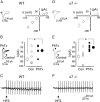In hippocampal oriens interneurons anti-Hebbian long-term potentiation requires cholinergic signaling via α7 nicotinic acetylcholine receptors
- PMID: 23325242
- PMCID: PMC6704869
- DOI: 10.1523/JNEUROSCI.1070-12.2013
In hippocampal oriens interneurons anti-Hebbian long-term potentiation requires cholinergic signaling via α7 nicotinic acetylcholine receptors
Abstract
In the hippocampus, at excitatory synapses between principal cell and oriens/alveus (O/A) interneurons, a particular form of NMDA-independent long-term synaptic plasticity (LTP) has been described (Lamsa et al., 2007). This type of LTP occurs when presynaptic activation coincides with postsynaptic hyperpolarization. For this reason it has been named "anti-Hebbian" to distinguish from the classical Hebbian type of associative learning where presynaptic glutamate release coincides with postsynaptic depolarization. The different voltage dependency of LTP induction is thought to be mediated by calcium-permeable (CP) AMPA receptors that, due to polyamine-mediated rectification, favor calcium entry at hyperpolarized potentials. Here, we report that the induction of this form of LTP needs CP-α7 nicotinic acetylcholine receptors (nAChRs) that, like CP-AMPARs, exhibit a strong inward rectification because of polyamine block at depolarizing potentials. We found that high-frequency stimulation of afferent fibers elicits synaptic currents mediated by α7 nAChRs. Hence, LTP was prevented by α7 nAChR antagonists dihydro-β-erythroidine and methyllycaconitine (MLA) and was absent in α7(-/-) mice. In addition, in agreement with previous observations (Le Duigou and Kullmann, 2011), in a minority of O/A interneurons in MLA-treated hippocampal slices from WT animals and α7(-/-) mice, a form of LTP probably dependent on the activation of group I metabotropic glutamate receptors was observed. These data indicate that, in O/A interneurons, anti-Hebbian LTP critically depends on cholinergic signaling via α7 nAChR. This may influence network oscillations and information processing.
Figures




Similar articles
-
Induction of Anti-Hebbian LTP in CA1 Stratum Oriens Interneurons: Interactions between Group I Metabotropic Glutamate Receptors and M1 Muscarinic Receptors.J Neurosci. 2015 Oct 7;35(40):13542-54. doi: 10.1523/JNEUROSCI.0956-15.2015. J Neurosci. 2015. PMID: 26446209 Free PMC article.
-
Nicotine facilitates long-term potentiation induction in oriens-lacunosum moleculare cells via Ca2+ entry through non-alpha7 nicotinic acetylcholine receptors.Eur J Neurosci. 2010 Feb;31(3):463-76. doi: 10.1111/j.1460-9568.2009.07058.x. Epub 2010 Jan 26. Eur J Neurosci. 2010. PMID: 20113344 Free PMC article.
-
Endogenously released ACh and exogenous nicotine differentially facilitate long-term potentiation induction in the hippocampal CA1 region of mice.Eur J Neurosci. 2012 May;35(9):1381-95. doi: 10.1111/j.1460-9568.2012.08056.x. Epub 2012 Mar 30. Eur J Neurosci. 2012. PMID: 22462479 Free PMC article.
-
Roles of distinct glutamate receptors in induction of anti-Hebbian long-term potentiation.J Physiol. 2008 Mar 15;586(6):1481-6. doi: 10.1113/jphysiol.2007.148064. Epub 2008 Jan 10. J Physiol. 2008. PMID: 18187472 Free PMC article. Review.
-
NMDA receptor-independent LTP in mammalian nervous system.Prog Neurobiol. 2021 May;200:101986. doi: 10.1016/j.pneurobio.2020.101986. Epub 2021 Jan 2. Prog Neurobiol. 2021. PMID: 33400965 Review.
Cited by
-
Possible Implication of the CA2 Hippocampal Circuit in Social Cognition Deficits Observed in the Neuroligin 3 Knock-Out Mouse, a Non-Syndromic Animal Model of Autism.Front Psychiatry. 2019 Jul 19;10:513. doi: 10.3389/fpsyt.2019.00513. eCollection 2019. Front Psychiatry. 2019. PMID: 31379628 Free PMC article.
-
Long-term plasticity in identified hippocampal GABAergic interneurons in the CA1 area in vivo.Brain Struct Funct. 2017 May;222(4):1809-1827. doi: 10.1007/s00429-016-1309-7. Epub 2016 Oct 25. Brain Struct Funct. 2017. PMID: 27783219 Free PMC article.
-
Calcium Dynamics in Dendrites of Hippocampal CA1 Interneurons in Awake Mice.Front Cell Neurosci. 2019 Mar 15;13:98. doi: 10.3389/fncel.2019.00098. eCollection 2019. Front Cell Neurosci. 2019. PMID: 30930750 Free PMC article.
-
Long-term potentiation in hippocampal oriens interneurons: postsynaptic induction, presynaptic expression and evaluation of candidate retrograde factors.Philos Trans R Soc Lond B Biol Sci. 2013 Dec 2;369(1633):20130133. doi: 10.1098/rstb.2013.0133. Print 2014 Jan 5. Philos Trans R Soc Lond B Biol Sci. 2013. PMID: 24298136 Free PMC article.
-
Theta patterns of stimulation induce synaptic and intrinsic potentiation in O-LM interneurons.Proc Natl Acad Sci U S A. 2022 Nov;119(44):e2205264119. doi: 10.1073/pnas.2205264119. Epub 2022 Oct 25. Proc Natl Acad Sci U S A. 2022. PMID: 36282913 Free PMC article.
References
-
- Frotscher M, Léránth C. Cholinergic innervation of the rat hippocampus as revealed by choline acetyltransferase immunocytochemistry: a combined light and electron microscopic study. J Comp Neurol. 1985;239:237–246. - PubMed
-
- Fucile S. Ca2+ permeability of nicotinic acetylcholine receptors. Cell Calcium. 2004;35:1–8. - PubMed
Publication types
MeSH terms
Substances
LinkOut - more resources
Full Text Sources
Other Literature Sources
Molecular Biology Databases
Miscellaneous
